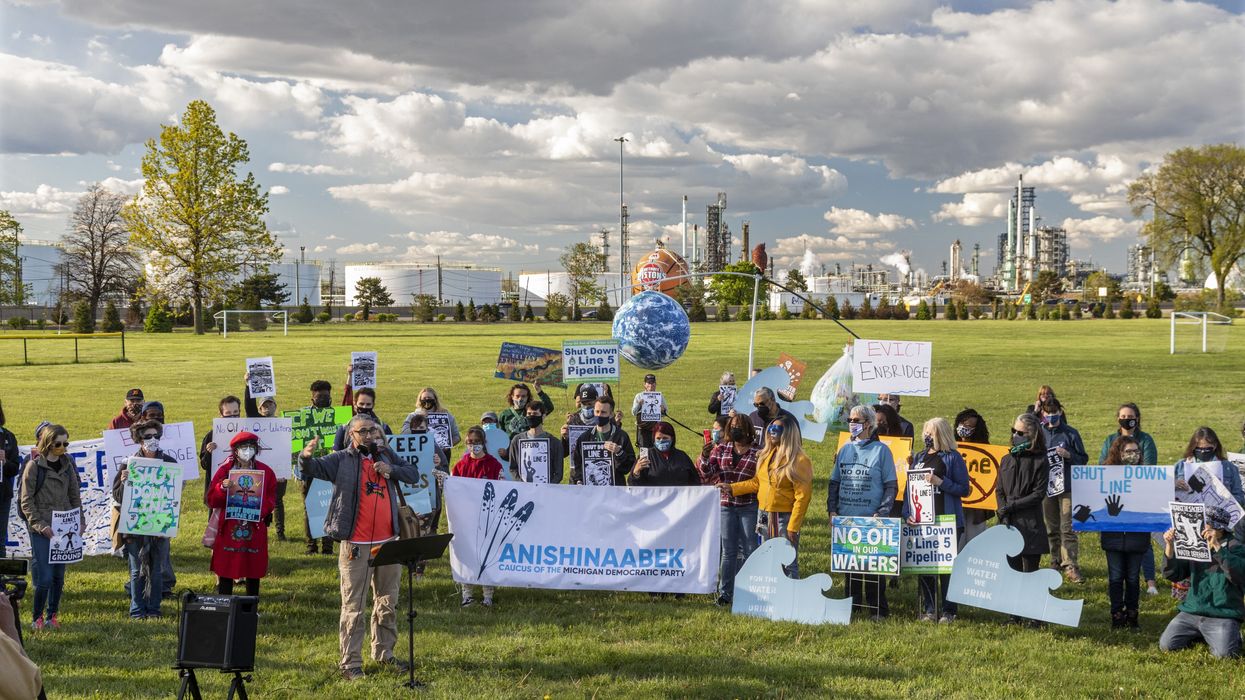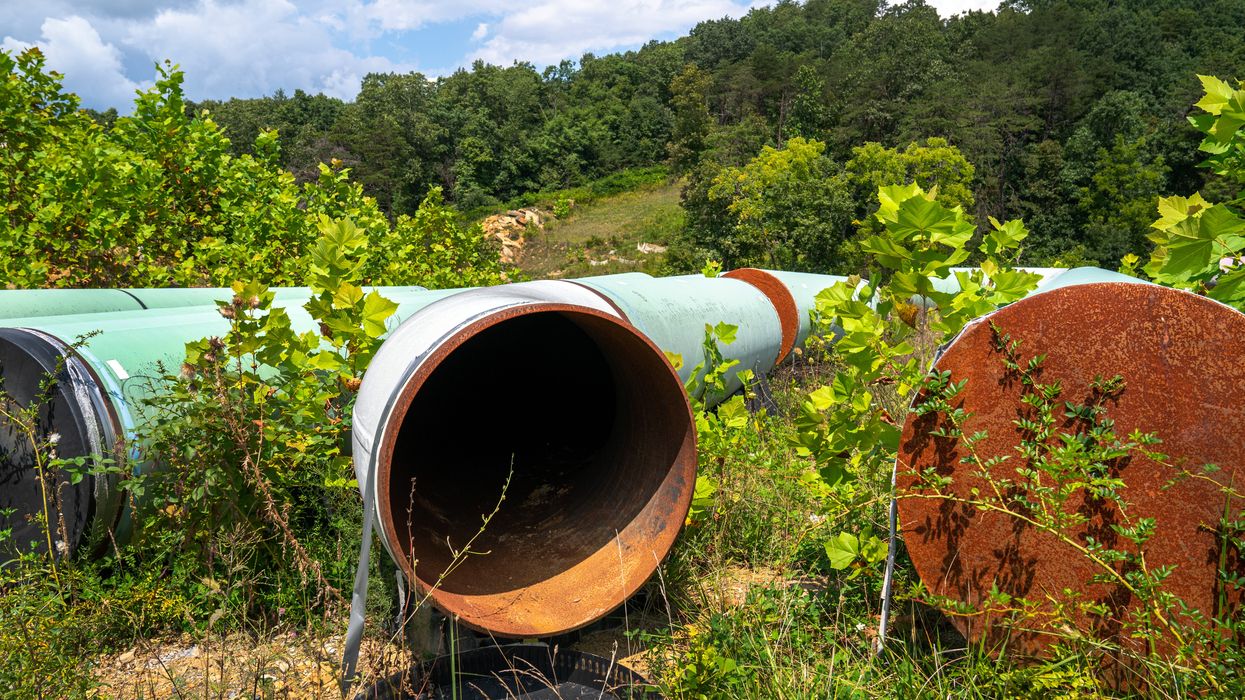At the heart of this struggle lies Enbridge’s Line 5—a 645-mile pipeline transporting crude oil and natural gas liquids from Wisconsin to Ontario. Line 5 does not stand alone but is linked to a much larger network of pipelines that begin in the tar sands fields of Canada and transport one of the dirtiest forms of fossil fuel. The aging Line 5 cuts directly through the Bad River Band’s reservation, but easements for this pipeline expired in 2013. Enbridge now plans to reroute the pipeline around the reservation despite years of legal battles and overwhelming public opposition. Enbridge has a well-documented history of spills and environmental destruction and, as an investor in the Dakota Access Pipeline, supported the violent attacks on Indigenous activists at Standing Rock. Enbridge’s reroute of Line 5 remains a direct threat to fragile ecosystems and Indigenous sovereignty.
At the same time, thousands of miles away, millions of Palestinians are being displaced and tens of thousands killed by an all-out military assault in Gaza that targets the entire population and infrastructure for life. This is accompanied by accelerating state-supported violence by Israeli settlers against Palestinians in the West Bank. The relentless bombings, mass displacement, deliberate starvation, and destruction of civilian life carried out by Israel and the U.S. against the Palestinian people amounts not to a conventional war but to genocide. The U.S. and Israel are now openly discussing a plan to permanently remove Palestinians and take over Gaza and the West Bank, completing a process of ethnic cleansing that has been ongoing for over 100 years.
What links a battle over a pipeline in Wisconsin to the crisis in Gaza and the West Bank? Everything. The fight against Line 5 isn’t merely about fossil fuels—it’s a stand against a global system of colonialism, militarism, and capitalism that drives the climate crisis. The ethnic cleansing and genocide directed at Palestinians represent the advancement of a long-term colonial project that uses violence and militarism to secure access to land and resources. In a critical moment when we face a rising tide of fascism in the U.S. and abroad, the deep connections between Line 5 and Gaza serve as a stark reminder of the urgent need for united, organized resistance to defend justice, the land, and human and nonhuman life.
Colonialism and Control: From Wisconsin to Gaza
Colonialism is about dominance and control. Whether imposed on Indigenous nations in the United States or on Palestinians abroad, its purpose is to grant powerful states and corporations unfettered access to land and resources, fueling profits and increased power for ruling elites.
In Gaza—and increasingly in the West Bank, southern Lebanon, and Syria—the brutal legacy of settler colonialism is on display. Since at least 1947, Israel has pursued colonization in Palestine, displacing native inhabitants and instituting an apartheid system to control those who remain. Military force and state-sponsored violence have systematically stripped Palestinians of their land, water, property, and freedom, a process bolstered by political, financial, and military support from Western powers. In particular, Israel is critical to strategic U.S. military and political presence in the Middle East; in other words, it is central to U.S. imperialism. The current crisis in Gaza is an escalation of this long-term project.
Climate justice movements in the U.S. must recognize not only the moral imperative but the strategic necessity of centering struggles for immigrant rights, Indigenous and Palestinian sovereignty, and struggles against militarism and fascism.
The systems at work in Gaza are the same as those that drive projects like Line 5. The history of the U.S. is one of colonial expansion, of violently appropriating land and resources from native inhabitants and transferring it to the U.S. government and settlers. Even now, the U.S. government and powerful corporate interests ignore the rights of Indigenous sovereign nations and ram through pipelines, mines, and other projects despite their environmental and social dangers and opposition from tribes. Projects like Line 5 are a continuation of a multi-century colonial project that stretches from from the Indian Wars in the 19th century to the militarized response to the Indigenous-led resistance to the Dakota Access Pipeline at Standing Rock.
Whether it manifests through violent repression of protest or the displacement of entire ethnic groups, the same colonial logic is at work. Israel’s occupation and blockade of Gaza aims to secure access to land, water, and offshore natural gas reserves for themselves and their corporate and political allies. The same drive for control and access to resources underpins Line 5, linking these two struggles in a broader fight against colonialism, exploitation, and global corporate power.
Militarism, Capitalism, and Global Solidarity
Militarism fuels colonialism. It is also essential to the fossil fuel industry, the core driver of the climate crisis. The U.S. military extends across an estimated 750 overseas bases in 80 countries. This web of influence props up transnational fossil fuel networks that depend on protection and the threat of force to extract and transport oil and gas around the globe. The paramilitary response to activists protesting the Dakota Access Pipeline and Line 3 in Minnesota are local examples that illustrate this relationship. The U.S. invests $800 billion into the military each year, money that could be spent on the public good but is instead used to underwrite a global system of extraction and exploitation.
The U.S. military also contributes to the climate crisis in more direct ways. The U.S. Department of Defense is the world’s largest institutional consumer of fossil fuels and is responsible for more greenhouse gas emissions than many nations. Wars and conflict contribute significantly to carbon emissions and also drive widespread environmental devastation that destroys local livelihoods. U.S. military bases are ranked as among the most polluted in the world, damaging land and water in surrounding areas with past nuclear testing and toxic chemicals.
Militarism is also deeply intertwined with corporate interests. Big defense contractors such as Lockheed Martin, Boeing, Oshkosh Defense, and Raytheon profit from the devastation in Gaza. Such contractors are also deeply intertwined with private security firms like Blackrock. These security firms are deployed by fossil fuel companies to protect fossil fuel infrastructure projects like Line 5, harming Indigenous communities and intensifying climate collapse. In short, the U.S. military reinforces a system that prizes profit over human life.
The struggles in Gaza and against Line 5 are two sides of the same coin. Palestinians resisting occupation and Indigenous nations opposing pipelines face the same force: militarized, transnational government-corporate alliances. Their fight is not solely for their own physical and cultural survival—it is a battle for justice and freedom for all people and the planet.
Climate Chaos, Fascism, and Migration
The climate crisis is inseparable from the forces of militarism, colonialism, and capitalism. Climate change is also contributing to a related crisis—the rise of fascism and the demonization of immigrants.
As global temperatures climb, environmental disasters and unpredictability increase, contributing to economic destabilization and a general sense of uncertainty and fear. This creates an ideal breeding ground for fascist ideologies that promise greater security (for some) through the exercise of state control, brute strength, and the scapegoating of the vulnerable—all while siphoning money and power to corporations. Climate change also drives the displacement of people, as extreme heat, flooding, drought, and other environmental disasters force entire regions into unlivable conditions. In 2022 alone, over 43 million people were displaced by climate-related events, from hurricanes and floods to shifts in agricultural viability. This number is set to grow, creating an ever-growing wave of climate refugees.
Indigenous and Palestinian struggles confront the same systems that aim to strengthen corporate and elite interests at the expense of everyday people and vulnerable populations, further deepening global inequality.
Rather than addressing the root causes of climate change, developing plans for adaptation that serve the public good, or offering refuge to those forced to migrate, many governments worldwide are responding with authoritarian measures. Fascist leaders paint climate refugees as threats, blaming migrants and marginalized communities for crises they did not create. In the U.S., we see this in the criminalization of immigration, mass deportation, the expansion of border walls, and the deployment of surveillance technologies—many of which were first developed in Israel and tested on Palestinians. These policies only worsen human suffering while deflecting attention from the real culprits: fossil fuel corporations, militarism, and capitalist greed.
These rising authoritarian impulses are deeply linked to the fight against Line 5 and resistance to Israel’s expansion. Indigenous and Palestinian struggles confront the same systems that aim to strengthen corporate and elite interests at the expense of everyday people and vulnerable populations, further deepening global inequality.
A Call to Action: Building Power to Fight Back
The November 2024 election and turn toward fascism in the U.S. have underscored the urgency of grassroots resistance. Corporate and right-wing forces are aligning in unprecedented ways, fueled by economic inequality, xenophobia, fear, and disinformation. Authoritarian regimes in the U.S. and abroad, including Israel, are poised to further expand corporate power, fossil fuel extraction, militarism, and state oppression in frightening ways. This convergence poses an escalating threat to human communities and the natural world.
The fight against Line 5, led by the Bad River Band, and the global solidarity movement for Palestine both stand at the forefront of grassroots resistance to these converging forces. Broadening our lens, we can see such resistance taking place all over the world: in the anti-pipeline struggles in East Africa, the efforts of Indigenous communities in the Amazon to protect their land and way of life, and the bravery of anti-mining activists in El Salvador, to name just a few examples. These movements remind us that these battles in specific places are part of a broader struggle against interconnected systems of oppression—something that has long been recognized by local communities and Indigenous-led organizations worldwide.
Our organizing must be both intersectional and international. We must connect struggles that have too often been treated in isolation. The same forces that drive the expansion of Line 5 and the attacks on Palestinian life are at work in militarized occupations and conflicts abroad, the construction of border walls and the criminalization of migrants, and the climate crisis itself. By challenging these forces at home, and acting in solidarity with those abroad, we strike at the roots of a global system of exploitation and oppression.
Climate justice movements in the U.S. must recognize not only the moral imperative but the strategic necessity of centering struggles for immigrant rights, Indigenous and Palestinian sovereignty, and struggles against militarism and fascism. We must forge alliances with diverse movements from Wisconsin to East Africa to the Philippines, recognizing that we succeed or fail together. Despite these dangerous and difficult times, a different world is possible when we unite and act as one.


